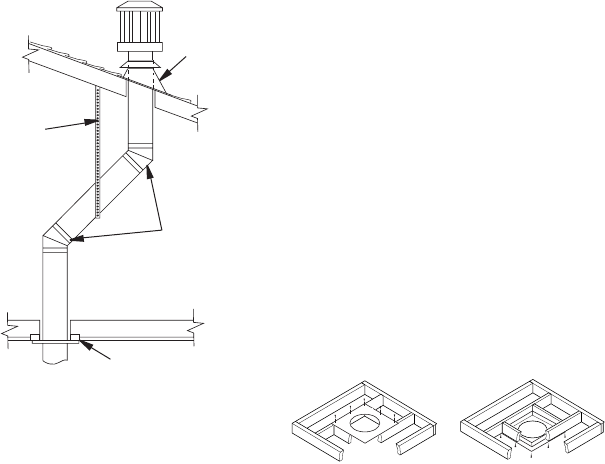
www.fmiproducts.com
116646-01J14
INSTALLATION FOR VERTICAL
TERMINATION
Note: Vertical restrictor must be installed in
all vertical installations.
1. Determine route your vertical venting
will take. If ceiling joists, roof rafters or
other framing will obstruct venting system,
consider an offset (see Figure 19) to avoid
cutting load bearing members. Note: Pay
special attention to these installation
instructions for required clearances (air
space) to combustibles when passing
through ceilings, walls, roofs, enclosures,
attic rafters, etc. Do not pack air spaces
with insulation. Also note maximum
vertical rise of venting system and any
maximum horizontal offset limitations.
2. Set replace in desired location. Drop a
plumb line down from ceiling to position
of replace exit ue. Mark center point
where vent will penetrate ceiling. Drill a
small locating hole at this point.
Drop a plumb line from inside of roof to
locating hole in ceiling. Mark center point
where vent will penetrate roof. Drill a small
locating hole at this point.
Flat Ceiling Installation
1. Cut a 11
1
/
2
" square hole in ceiling using locat-
ing hole as a center point. Opening should be
framed to 11
1
/
2
" x 11
1
/
2
" inside dimensions,
as shown in Figure 9 on page 9 using framing
lumber the same size as ceiling joists. If area
above the ceiling is an insulated ceiling or an
attic, nail restop from top side. This prevents
loose insulation from falling into required
clearance space. If area above ceiling is a
living space, install restop below framed
hole. Firestop should be installed with no less
than 3 nails per side (see Figure 20).
2. Assemble desired lengths of pipe and
elbows necessary to reach from replace
ue up through restop. Be sure all pipe
and elbow connections are fully twist-
locked (see Figure 8, page 9).
3. Cut a hole in roof using locating hole as
a center point. (Cover any exposed open
vent pipes before cutting hole in roof.) The
11
1
/
2
" x 11
1
/
2
" hole must be measured
on the horizontal; actual length may be
larger depending on pitch of roof. There
must be a 1" clearance from vent pipe to
combustible materials. Frame opening as
shown in Figure 9, page 9.
4. Connect a section of pipe and extend up
through hole.
Note: If an offset is needed to avoid
obstructions, you must support vent pipe
every 3 feet. Use wall straps for this pur-
pose (see Figure 19). Whenever possible,
use 45° elbows instead of 90° elbows. The
45° elbow offers less restriction to the ow
of ue gases and intake air.
5. Place ashing over pipe section(s) ex-
tending through roof. Secure base of
ashing to roof and framing with roong
nails. Be sure roong material overlaps
top edge of ashing as shown in Figure
19. There must be a 1" clearance from
vent pipe to combustible materials.
Figure 20 - Installing Firestop
If area above is a
living space, install
restop below framed
hole.
If area above is an
attic or insulated
area, install restop
above framed hole.
VENTING INSTALLATION
Continued
Figure 19 - Offset with Wall Strap and 45°
Elbows
45° Elbow
Wall Strap
Roof
Flashing
Ceiling
Firestop


















